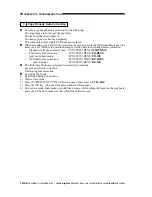
COPYRIGHT © 1999 CANON INC. CANON imageRUNNER 400/330 REV.0 JAN. 1999 PRINTED IN JAPAN (IMPRIME AU JAPON)
14-33
CHAPTER 14 TROUBLESHOOTING
III. TROUBLESHOOTING
IMAGE FAULTS
A. Initial Checks
1. Checking the Site Environment
a. The power supply voltage must be as
rated (±10%). (Do not disconnect the
power plug at night.)
b. The machine must not be subject to high
temperature/humidity (near water faucets,
water boilers, humidifiers) or cold. It must
not be near sources of fire or in an area
subject to dust.
c. The machine must not be subject to
ammonium gas.
d. The machine must not be exposed to
direct sunshine. (As necessary, provide
curtains.)
e. The room must be ventilated well.
f. The floor must be level.
g. The machine must remain powered
throughout day and night.
Check the site against the foregoing
requirements.
2. Checking the Originals
Determine whether the problem is due to
the original or the machine.
a. The copy density lever must normally be
at 5 ±1.
b. Reddish originals can produce copies with
poor contrast; e.g., red sheets, slips.
c. Diazo copies or originals with
transparency tend to produce outputs
easily mistaken for "foggy" copies.
Originals prepared in light pencil can
produce outputs easily mistaken for "light"
images."
3. Checking Parts
Check the copyboard cover, copyboard
glass, and standard white plate for scratches or
dirt.
If soiled, clean the part with mild
detergent or alcohol; if scratched, replace it.
4. Checking the Charging Assemblies
a. Check the charging assemblies for dirt
and the charging wires for a fault (scar).
b. Clean the charging rollers, shield plate,
and block (front, rear) for dirt. If the dirt
cannot be removed, replace the part.
c. Check to make sure that all charging
assemblies are set properly.
















































